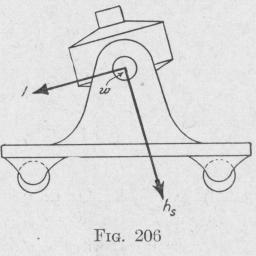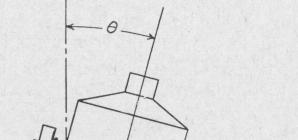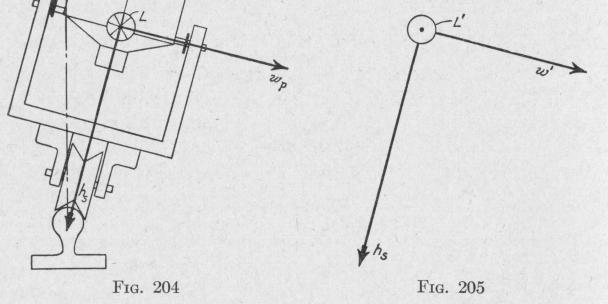260 GYROSCOPIC STABILIZATION
GYROSCOPICALLY STABILIZED MONORAIL CARS 261
precession axis is made greater than the precession velocity due to the gravitational torque. The angular velocity of the spin-axle may be increased by a motor or other outside agent. There is now an unneutralized righting torque, L". For maximum effect, the acceleration of the precessional velocity produced by the motor should stop when the free precession stops. The direction of the acceleration should reverse when the direction of precession re- verses. The righting torque L" should comprise two components, one that is proportional to the instantaneous precessional velocity, and one that is proportional to the angle of precession at that instant.
159. The Effect of a Change in Linear Velocity on the Stability of a Monorail Car that Carries a Single Statically Unstable Gyro- scope with Vertical Spin-Axle. - First, consider the effect of a
change in the magnitude of the ve- locity of the car. If the speed of the car be increased when moving from left to right on a straight rail, Fig. 206, the center of gravity of the gyro-system will hang backward causing the upper end of the gyro- axle to tilt backward. The tilting is in the direction indicated by w. Suppose that the gyro spins in the direction indicated by h3. Accom-
panying the tilting backward of the spin-axle is a torque acting on the gyro in the direction indicated by L (Art. 36). This torque tilts the gyro and the attached car to one side of the verti- cal through the rail. If the linear velocity of the car be de- creased, the spin-axle will tilt forward and the car will tilt in the direction opposite that when the velocity of the car is increased. When the linear velocity of the car becomes constant, the car will oscillate from side to side about its position of equilibrium.
Now, consider the effect upon the stability of the car produced by motion around a curve. Figure 207 represents a monorail car, going away from the reader and carrying a statically unstable gyroscope. If the gyro were not spinning and the car started to go around a curve, the car would tilt away from the center of the curve, thereby exerting a gravitational torque L on the gyro. If the gyro is spinning in the direction indicated by the arrow hs, this torque causes the spin-axle to precess in the direction indicated
I
begins to precess. If the spin velocity is in the direction indicated by h,j the direction of the precession is as indicated by wp. Just as soon as the gyro-axle is deflected from the vertical, the gyro and casing begin to fall in the direction of the gyroscopic precession, thereby increasing the velocity about the precession axis in a given time by an amount w', Fig. 205. A righting torque L' now acts on the car (Art. 36). If this righting torque is large enough, it brings the car back toward the upright position in spite of the gravitational torque that tends to tip it over further. But if the righting torque is large enough to bring the car to the upright position it is likely to carry it beyond that position.
The action is similar if the velocity of the spin-axle about the
side shall be neutralized by a torque produced within. In all methods thus far used for causing a monorail car to erect itself after becoming tilted from the vertical, the tilting causes the spin- axle of a gyroscope to precess and the velocity of precession is caused to be accelerated by some torque. The differences in the various schemes have been in the number of gyroscopes employed, the direction of the spin-axles relative to the rail and in the method used to produce the acceleration of the spin-axles.
Consider a monorail car in which is mounted a single gyroscope with vertical spin-axle capable of precessing about an axis trans-
verse to the car, Fig. 204. Sup-
pose pose that the gyro and casing
are mounted so as to constitute
a statically unstable system.
Just as soon as the car tilts
from the vertical, the spin-axle


